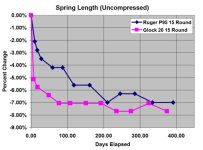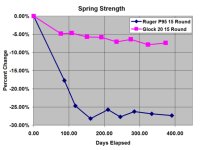I know, it's a "fun" topic.
It's always entertaining because everyone seems to be an expert on the topic and people tend to have strong opinions about it. It remains an entertaining/exciting subject because there's not much empirical data to rely on which means that it's not easily put to rest.
Awhile back I came up with an idea for a homemade spring tester and built it. You can read about it here.
In December 2013, I picked a new magazine from my safe and started a test. In January 2014, I chose a second magazine and added it to the test.
The first magazine has now been loaded 391 days. The second one 374 days. Neither magazine has been used except in this test. The only loading and unloading that either magazine has experienced is the bare minimum required for the testing. In both cases, that amounts to fewer than 15 loading/unloading cycles.
Both magazines are new, unmodified, factory magazines.
At the beginning of the test, both magazines were disassembled and the uncompressed spring lengths were measured and recorded. The spring strengths at a given compression length were also recorded.
Then each magazine was fully loaded (15 rounds in both cases) and stored in the safe.
At intervals, each magazine was unloaded and disassembled. The springs were measured both for uncompressed length and compressed strength at the same compression depths used in the initial measurements.
The graphs show the results.


It's interesting that both springs showed similar behavior in terms of how the uncompressed spring length changed.
It's just as interesting to see that they behaved very differently in terms of the spring strength changes.
The Ruger P95 magazine steadily lost strength through the first 160 days of the test but then seems to have leveled off at about 27% strength loss. It's worth noting that I tested the magazine in a P95 after the last measurement was taken and the spring is still strong enough to lock the slide back with no problem. I don't intend to test either spring by shooting until I'm completely done with the test.
The Glock 20 magazine has lost very little strength overall but the graph seems to have a slight but steady overall downward trend that apparently is continuing.
Obviously both springs lost a measurable amount of strength (significantly different amounts) and uncompressed length (remarkably similar amounts) from being left loaded.
I'm going to keep the test going until I'm reasonably certain that neither spring is changing any more. If there are any significant changes, I'll post updates.
So some springs do seem to weaken significantly from merely being left loaded. Others do not. How do you know which you have? Short of running a very lengthy test, you probably won't know. How can we deal with this constructively?
My advice is to check your self-defense equipment regularly (we should all be doing this anyway. Right?). If you note springs weakening from being left loaded, replace them with high-quality parts--first you want to eliminate the possibility of quality issues. If they weaken again from being left loaded, replace the springs again but now you've determined that even quality springs may weaken in your magazine design if left fully loaded for long periods. You have two options at this point. You can either underload the mags by a round or two (the last little bit of compression is the hardest on the spring) or you can determine how long the springs will last and simply replace them before they weaken enough to cause malfunctions. Mag springs are cheap, even the best ones.
It is worth pointing out that this test shows not all magazine springs weaken significantly from being left loaded. In fact, as nearly as I can determine, it's not particularly common for magazine springs to weaken from being left loaded to the point that they cause malfunctions. But it can happen and we need to be aware of the possibility so it doesn't take us by surprise. It's one thing to find weak magazine springs at the range or during a routine check. It's another thing entirely to discover the problem during a self-defense encounter.
It's always entertaining because everyone seems to be an expert on the topic and people tend to have strong opinions about it. It remains an entertaining/exciting subject because there's not much empirical data to rely on which means that it's not easily put to rest.
Awhile back I came up with an idea for a homemade spring tester and built it. You can read about it here.
In December 2013, I picked a new magazine from my safe and started a test. In January 2014, I chose a second magazine and added it to the test.
The first magazine has now been loaded 391 days. The second one 374 days. Neither magazine has been used except in this test. The only loading and unloading that either magazine has experienced is the bare minimum required for the testing. In both cases, that amounts to fewer than 15 loading/unloading cycles.
Both magazines are new, unmodified, factory magazines.
At the beginning of the test, both magazines were disassembled and the uncompressed spring lengths were measured and recorded. The spring strengths at a given compression length were also recorded.
Then each magazine was fully loaded (15 rounds in both cases) and stored in the safe.
At intervals, each magazine was unloaded and disassembled. The springs were measured both for uncompressed length and compressed strength at the same compression depths used in the initial measurements.
The graphs show the results.
It's interesting that both springs showed similar behavior in terms of how the uncompressed spring length changed.
It's just as interesting to see that they behaved very differently in terms of the spring strength changes.
The Ruger P95 magazine steadily lost strength through the first 160 days of the test but then seems to have leveled off at about 27% strength loss. It's worth noting that I tested the magazine in a P95 after the last measurement was taken and the spring is still strong enough to lock the slide back with no problem. I don't intend to test either spring by shooting until I'm completely done with the test.
The Glock 20 magazine has lost very little strength overall but the graph seems to have a slight but steady overall downward trend that apparently is continuing.
Obviously both springs lost a measurable amount of strength (significantly different amounts) and uncompressed length (remarkably similar amounts) from being left loaded.
I'm going to keep the test going until I'm reasonably certain that neither spring is changing any more. If there are any significant changes, I'll post updates.
So some springs do seem to weaken significantly from merely being left loaded. Others do not. How do you know which you have? Short of running a very lengthy test, you probably won't know. How can we deal with this constructively?
My advice is to check your self-defense equipment regularly (we should all be doing this anyway. Right?). If you note springs weakening from being left loaded, replace them with high-quality parts--first you want to eliminate the possibility of quality issues. If they weaken again from being left loaded, replace the springs again but now you've determined that even quality springs may weaken in your magazine design if left fully loaded for long periods. You have two options at this point. You can either underload the mags by a round or two (the last little bit of compression is the hardest on the spring) or you can determine how long the springs will last and simply replace them before they weaken enough to cause malfunctions. Mag springs are cheap, even the best ones.
It is worth pointing out that this test shows not all magazine springs weaken significantly from being left loaded. In fact, as nearly as I can determine, it's not particularly common for magazine springs to weaken from being left loaded to the point that they cause malfunctions. But it can happen and we need to be aware of the possibility so it doesn't take us by surprise. It's one thing to find weak magazine springs at the range or during a routine check. It's another thing entirely to discover the problem during a self-defense encounter.


